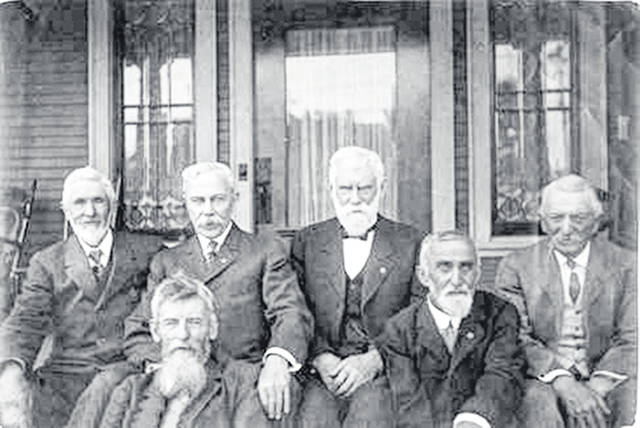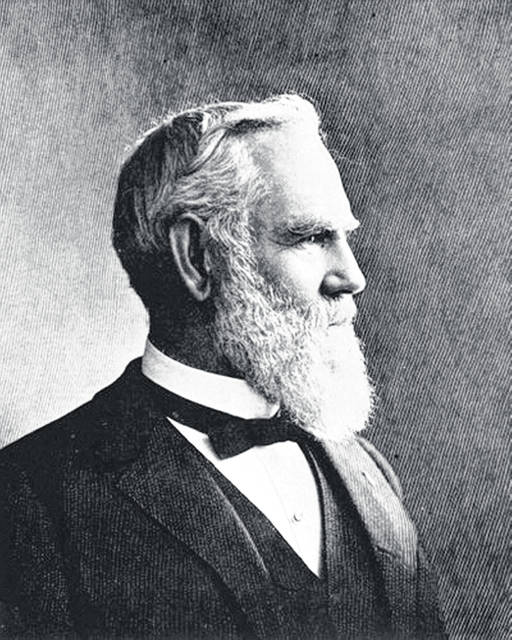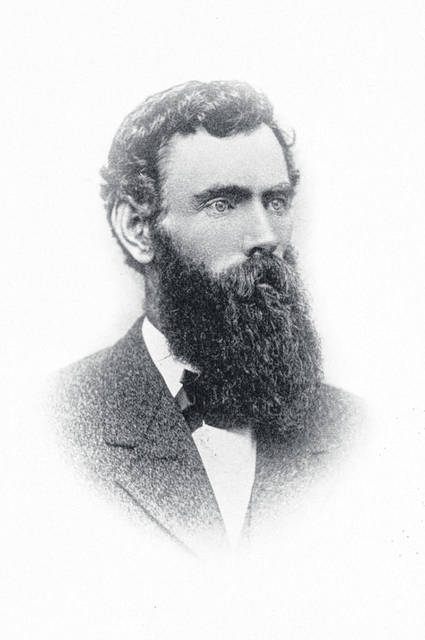



Editor’s note: This article is one in an occasional series of articles about Shelby Countians who served in the Civil War. The series will run in advance of Sidney’s Civil War Living History Weekend. James (Ginn) Guinn is a third cousin of retired Mutual Federal Savings Bank President Doug Millhoff. The next Civil War Living History Weekend is scheduled for Sept. 19 and 20, 2020, coinciding with the celebration of Sidney’s Bicentennial.
SIDNEY — James Miller Ginn was born Nov. 27, 1837, near present-day Houston.
He was the son of Scots-Irish immigrants who came to the Americas in 1819. His parents moved to Ohio in 1830. Not unlike many early settlers, his family came to America in search of religious freedom.
In their quest for freedom to worship as they pleased, his paternal and maternal ancestors had moved from Scotland and settled in northern Ireland in the latter part of the 17th century. His father was born near Enniskillen, and his mother, Eliza Miller, was born near Londonderry.
After spending a decade in New Brunswick, Canada, engaged in the lumber business, the Ginn family moved to Ohio and located in Shelby County on a tract of land covered with dense forest. James Ginn spent his boyhood years working alongside his father and his eight siblings, helping to clear the large trees on their 300-acre property so that crops could be planted and the family could survive.
For a few months each winter, James attended classes in a small, rough-hewn log schoolhouse. By studying in the evening after the day’s chores were finished, he obtained enough of an education that by age 18, he was able to begin his own career as a teacher. For a couple of years, he engaged in both farming and teaching.
Anxious to obtain a better education, he enrolled in Antioch College (many early colleges offered a preparatory school in which originality was not prized, but rather the ability to memorize a set of known facts was). Ginn was greatly influenced by Horace Mann, the father of the Common School Movement and the first president of Antioch College. With great success, Mann argued that universal public education was the best way to turn unruly American children into disciplined, judicious, republican citizens.
In 1858, James entered Oberlin College. He was entirely dependent on his own funds to pay for his college expenses. By teaching during vacations, by manual labor and by literally pinching pennies, he was able to work his way through college and even graduate with honors.
Enlists in Ohio Volunteer Infantry
With the outbreak of the Civil War, Ginn was among the very first to respond to President Lincoln’s call for volunteers. Ginn enlisted, April 19, 1861, five days after the fall of Fort Sumter. He was a member of Company C, 7th Regiment, Ohio Volunteer Infantry. Although the original enlistment period was for a period of 90 days, he reenlisted in the same regiment for another three years.
Ginn mentions reenlisting in a letter home to his sister dated May 25, 1861: “When I enlisted at Oberlin, I supposed I had made all the sacrifice I should be called upon to make. But today we have been called upon to make a greater. We have been called upon to volunteer our services for three years, or to the close of the war. It is one of the most momentous questions I have ever been called upon to decide. I have thought upon it much and have looked at it from every light and I have finally come to the conclusion to volunteer.”
His regiment was among the first sent into western Virginia. He served through the West Virginia campaign under Major General George B. McClellan and after McClellan was given command of the Army of the Potomac, under Brigadier General William S. Rosecrans.
In August 1861, while the 7th Regiment was guarding Carnifax Ferry, it was attacked by 3,000 Confederates under Generals Floyd and Wise. After desperate resistance, the troops were forced to retreat, leaving both dead and wounded on the field.
During the retreat, Ginn’s company was ambushed and nearly one-half of those who escaped from the battlefield were captured. Ginn was able to escape capture, however, and after traveling for five days through the mountain terrain subsisting on a few berries and leaves of wintergreen, he was able to reach Union forces at Gauley Bridge, almost starved.
In a letter to his sister dated Sept. 10, 1861, Ginn recounts his experience: “Our men fought bravely. Our company fought the longest of any other. We stood the fire of two regiments and held them at check for half an hour. If we could have had another company to sustain us we would have whipped the scoundrels. Our company retreated to the woods in good order, and would have gotten through safely had we not run into the cavalry. Our captain was taken prisoner then, not killed as the paper reports. We have heard that fifteen of our men were taken prisoner. The rest of us scattered in the woods and got in at different times. I was three days and two nights in the woods on one meal. I had to eat berries and leaves to keep from starving.”
The 7th Regiment joined the Army of the Potomac in the fall of 1861 and took part in all the great battles in which that army was engaged. Some of those included the battles of Blue’s Gap, Kernstown, Winchester, Port Republic, Second Bull Run, Antietam, Chancellorsville and Gettysburg.
At the battle of Cedar Mountain (Aug. 9, 1862), Ginn’s regiment lost 66 percent of those engaged — a percentage of loss nearly twice as great as that of the Light Brigade in its famous charge at Balaklava. Of the 23 members of Ginn’s company who went into the battle, only six came out unhurt. Ginn was one of the fortunate six.
In September 1863, the regiment, as part of the 12th Army Corps, was ordered to Tennessee to participate in the Chattanooga campaign and was engaged in the battles of Lookout Mountain, Missionary Ridge and Ringgold. The 7th Ohio’s enlistment ended, and the troops were mustered out, June 1, 1864, in front of Atlanta.
Of his military service, one of Ginn’s comrades wrote after the war in a history of the company: “Promoted to corporal November 1, 1862; took part in the battles of Cross Lanes, Winchester, Port Republic, Cedar Mountain, Second Bull Run, Antietam, Dumfries; on every march of the company till his discharge January 12, 1863.”
After his discharge, Ginn was commissioned in October a captain by Ohio Governor Tod in a new regiment that was forming. Ginn was forced to decline the honor, as he never fully recovered his health, which had suffered, while he was in the army, as a result of hard service and exposure.
Traveling to California
In 1864, he traveled to California (walking across the Isthmus of Panama) in the hope that the warmer climate would help restore his health. After teaching school three months in Alameda County, he joined the gold rush to Idaho, packing his blankets on his back and footing it from Umatilla, Oregon, to the Boise Basin, a distance of 300 miles.
For three years, he followed gold mining with varying success, sometimes striking it rich and again dead broke. After his health failed yet again, Ginn returned to California in 1867. In 1868, he traveled to Danville, New York, and took treatment at Jackson Sanatorium. He remained there several months under the care of Dr. James C. Jackson, whose “water cure” included a combination of hot baths, sitz baths and massages.
It was about this time that Ginn changed his surname to Guinn. Family tradition indicates that an individual using the Ginn name had fallen on difficult circumstances. To avoid confusion with this individual and the legal liability it potentially involved, Ginn changed his name.
He returned to California in 1869. In October, he was appointed principal of the schools at Anaheim, a position he filled for the following 12 years. Although Guinn had but $10 when he arrived in Anaheim, he invested the money saved from his salary in land. At the end of 12 years, he sold his properties for $15,000 (the equivalent of $334,000 today).
During the greater portion of the time he was employed in the Anaheim schools he was a member of the county board of education. He helped to organize the first teachers’ institute (October 31, 1870) ever organized in the county.
Marries a teacher
In 1874, he married Dapsileia Marquis, a teacher under his supervision and the daughter of the Rev. John Marquis, a noted Presbyterian minister. The couple had three children. They include Mabel Elisabeth, Edna Marquis and Howard James.
In 1881, Guinn was appointed superintendent of the city schools of Los Angeles. He filled the position of school superintendent for two years.
Guinn then engaged in merchandising, which he followed for three years. Selling out, he engaged in the real estate and loan business, safely passing through the real estate boom.
A staunch Republican, as so many of the former Union soldiers were, he was the deputy assessor for Los Angeles County for several years. Guinn served as secretary of a Republican club before he was old enough to vote. He cast his first vote in 1856 for John C. Fremont, the first candidate of the anti-slavery Republican Party for the office of President of the United States. He voted for every Republican nominee for president thereafter.
In 1873, when Los Angeles County was overwhelmingly Democrat, he was the Republican nominee for the assembly. Because of his popularity, he came within 52 votes of being elected.
In 1875, he was the nominee of the anti-monopoly wing of the Republican Party for the position of state superintendent of public instruction. For the sake of party unity, he withdrew just prior to the election and asked his supporters to vote in favor of Ezra Carr. As a result, Carr was triumphantly elected.
In 1881, Guinn lost by the narrowest of margins a race for the State Assembly. Guinn served a number of years on the Republican county central committee and was elected secretary, a position he held from 1884 to 1886.
Guinn was one of 22 men who organized the Historical Society of Southern California (1883). Guinn subsequently held every office within the society and further enhanced his reputation as an historian. For the entire history of the organization until his death, he served on the board of directors.
A prolific writer, Guinn contributed a number of valuable historical papers to both magazines and newspapers. He edited the Historical Society’s annual for more than a quarter century and contributed more than 100 articles for that publication.
While engaged in the profession of teaching, Guinn was a frequent contributor to educational periodicals. He ranked high as a lecturer on educational subjects before teachers’ institutes and associations.
A charter member of the Grand Army of the Republic Stanton Post No. 8055, Guinn served as post commander. He filled the position of post adjutant continuously for more than a quarter century. In 1908, he was appointed assistant adjutant general of the Department of California and Nevada, Grand Army of the Republic, and served one year.
A founder of the Society of Pioneers of Los Angeles County (1897), he was one of a committee of three selected to draft a form of organization, constitution and by-laws. Guinn filled the office of secretary and also that of a member of the board of directors for 10 years.
In 1904, Guinn was nominated to serve as a member of the Los Angeles Board of Education by the Non-partisan Committee of One Hundred. The Non-partisans were elected by a majority of 3,000 over their Republican opponents while at the same time, the Republicans carried the city by a majority of more than 12,000. He served as a member of the board of education continuously for 10 and a half years, including a term as president.
During Guinn’s entire service on the board of education, excepting the year he was president, he was a member of the building committee. The committee had the responsibility to approve the purchase of the sites for schools and to issue the contracts for the building of schools. He served eight years as chairman of the committee.
Guinn was also a member of the finance committee for seven years. During his service on these committees, he approved the expenditure of more than $7 million (more than $182 million today) for the purchase of sites and the erection of buildings.
Guinn was elected a member of the board of governors of the Los Angeles County Museum of History Science and Art (now the Natural History Museum of Los Angeles) in February 1910. He took an active part in the organization of the museum and in making collections for its historical department.
Guinn became a member of the American Historical Association (Washington, D. C.) in 1893. At the time, the association included in its membership all the leading historians of the United States. When he joined, he was the sole member from Southern California.
Guinn filled the position of president of the Pacific Coast Branch of the American Historical Association in 1912. In 1914, Guinn received a gubernatorial appointment to serve on the California Historical Commission. In the final years of his life, he wrote an increasing number of articles and books, many of them detailing the history of California, with an emphasis on Southern California.
Following a brief illness, Guinn died at his home in Highland Park, Los Angeles, Sept. 24, 1918. Daughter Edna Marquis died May 1, 1910. Son Howard James died Nov. 21, 1919. Mrs. Guinn died March 17, 1929. Daughter Mable Elisabeth lived until June 19, 1968. None of the children ever married. The family is interred in the Angelus Rosedale Cemetery in Los Angeles.
There is an elementary school (K-6) named for James M. Guinn in Anaheim, California (1051 Sunkist St.). The school is one of 24 public elementary schools in the Anaheim Elementary School District. It has a current enrollment of 675 students.
There is an archive of James M. Guinn’s papers at The Huntington Library in San Marino, California. The collection contains the papers of Southern California educator and historian J.M. Guinn chiefly dating from 1870 to 1918 and including Guinn’s research notebooks; drafts of books speeches and papers; correspondence, with some letters written by Guinn while a Union soldier during the Civil War; and ephemera. The collection comprises several accessions, including gifts from Mabel E. Guinn in 1951 and 1959, purchases from Dawson’s L.A in 1965-1966, and a purchase from Burger & Evans in 1971.


In the final years of his life, James Miller (Ginn) Guinn was one of the country’s most respected historians.

The earliest known photo of James Miller (Guinn) Ginn is believed to date from his final year at Oberlin College (1861).

James M. Guinn was one of the founders of the Los Angeles County Museum of History, Science and Art. The museum, now the National History Museum of Los Angeles, opened in 1913.

